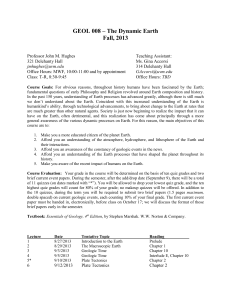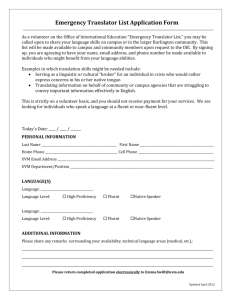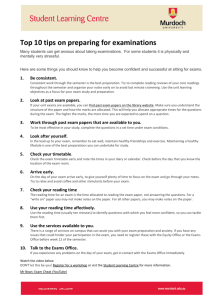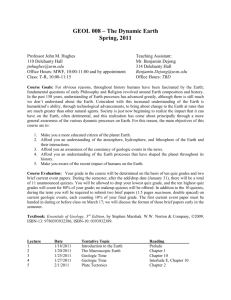BIOL 009: Science as a Way of Knowing
advertisement
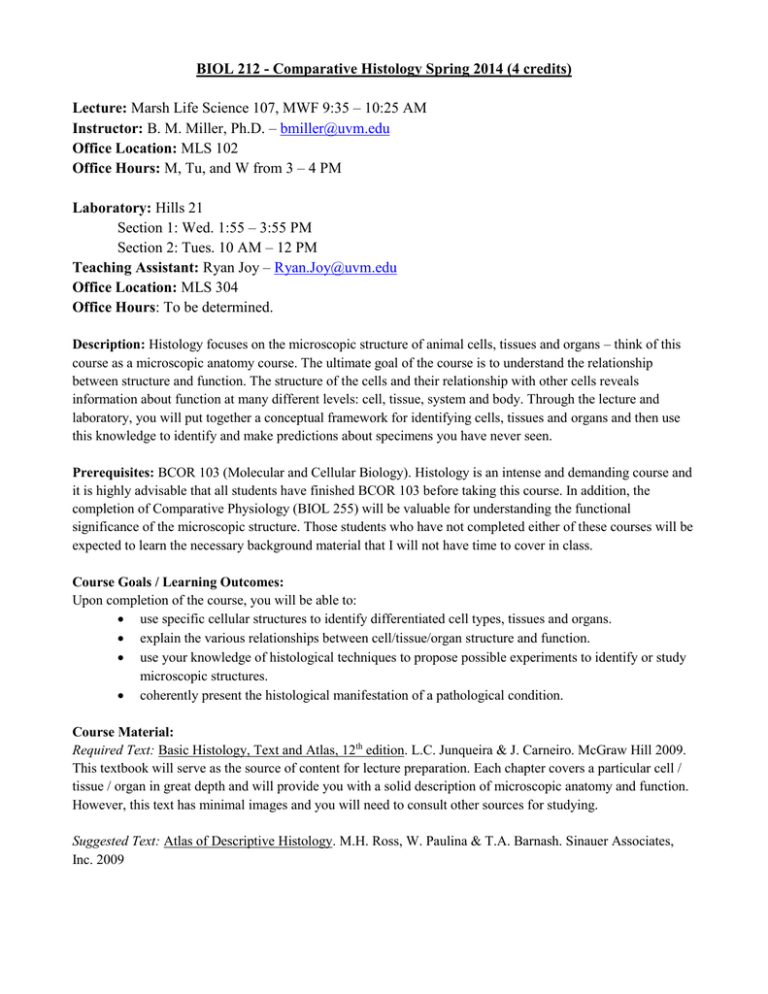
BIOL 212 - Comparative Histology Spring 2014 (4 credits) Lecture: Marsh Life Science 107, MWF 9:35 – 10:25 AM Instructor: B. M. Miller, Ph.D. – bmiller@uvm.edu Office Location: MLS 102 Office Hours: M, Tu, and W from 3 – 4 PM Laboratory: Hills 21 Section 1: Wed. 1:55 – 3:55 PM Section 2: Tues. 10 AM – 12 PM Teaching Assistant: Ryan Joy – Ryan.Joy@uvm.edu Office Location: MLS 304 Office Hours: To be determined. Description: Histology focuses on the microscopic structure of animal cells, tissues and organs – think of this course as a microscopic anatomy course. The ultimate goal of the course is to understand the relationship between structure and function. The structure of the cells and their relationship with other cells reveals information about function at many different levels: cell, tissue, system and body. Through the lecture and laboratory, you will put together a conceptual framework for identifying cells, tissues and organs and then use this knowledge to identify and make predictions about specimens you have never seen. Prerequisites: BCOR 103 (Molecular and Cellular Biology). Histology is an intense and demanding course and it is highly advisable that all students have finished BCOR 103 before taking this course. In addition, the completion of Comparative Physiology (BIOL 255) will be valuable for understanding the functional significance of the microscopic structure. Those students who have not completed either of these courses will be expected to learn the necessary background material that I will not have time to cover in class. Course Goals / Learning Outcomes: Upon completion of the course, you will be able to: use specific cellular structures to identify differentiated cell types, tissues and organs. explain the various relationships between cell/tissue/organ structure and function. use your knowledge of histological techniques to propose possible experiments to identify or study microscopic structures. coherently present the histological manifestation of a pathological condition. Course Material: Required Text: Basic Histology, Text and Atlas, 12th edition. L.C. Junqueira & J. Carneiro. McGraw Hill 2009. This textbook will serve as the source of content for lecture preparation. Each chapter covers a particular cell / tissue / organ in great depth and will provide you with a solid description of microscopic anatomy and function. However, this text has minimal images and you will need to consult other sources for studying. Suggested Text: Atlas of Descriptive Histology. M.H. Ross, W. Paulina & T.A. Barnash. Sinauer Associates, Inc. 2009 A specific atlas of images is not required for the laboratory; there will be multiple atlases available for you to use during the laboratory time. However, you may find that when studying for the exams you would like to have your own copy. This atlas comes recommended from previous students. A few recommended online sources of histological images: 1) Medical Histology and Virtual Microscopy Learning Resources http://www.med.umich.edu/histology/dmindex.html#virtualSlidebox 2) Boston University: Histology Learning System http://www.bu.edu/histology/m/i_main00.htm Prior students have found these sites helpful when observing the slides in the laboratory and when studying for the exams. Please note that there are many sources of images. Pre-Lecture Journal: You are expected to have read the assigned material prior to coming to lecture. To help you prepare for each lecture I will be providing questions on Blackboard for you to answer as you are reading. The answers to these questions should be submitted as a journal entry prior to the start of each non-Discussion or Student Poster Day. The Journal Tool link can be found under the Lecture Materials tab in Blackboard. These questions will help provide a foundation for learning the lecture material, answering in-class questions or making appropriate connections. The answers to these questions will also be part of what you are expected to know for the exams. Periodically throughout the semester I will check to see that you are doing the preparatory work, but I will not grade the answers. Thorough completion of these journal entries will count towards your participation grade. Lecture Format: We will spend the majority of our time in lecture discussing the anatomical features of a given tissue or organ system and their relationship to functional properties. Multiple times during the semester, I have set aside Discussion Days where you will have an opportunity to learn these anatomical features by identifying and labeling unknown images. Grading: Lecture Exams (2 at 15% each) 30 % Final Exam (Comprehensive) Student Poster Lecture Preparation Laboratory 20 % 15 % 10 % 25 % Grading Scale: The scale for final grades will be determined at the end of the semester, however, it will not deviate significantly from a standard scale (ie: 90-100 is an A-/A, etc.). Grade Adjustments: In addition to the criteria listed above, I will be noting student contributions during lecture days and overall effort in the course. I reserve the right to use this information at the end of the semester to adjust grades up to the next letter grade for those students on the border (e.g. C+ to B-). Exam Format There will be three exams in the course. The first two will be given during the laboratory session in order to allow adequate time to complete the exam (~2 hours). The final exam is cumulative and will also take place in the laboratory room. There will be at least two final exam times, each accommodating about half of the students. One will be during the normal final exam period for BIOL 212 and the second during a time (to be determined later) that will accommodate the other half of students. Make-up exams will be allowed ONLY as long as I am contacted PRIOR to the start of class on the day of the exam. Exams will cover content from lecture and lab. Assessment during the exams will be a combination of short answer, identification / labeling, matching, and/or true/false. Student Poster Presentation: During the last full week of the semester each student will create a poster presenting the histological manifestation of a particular condition (7-8 students per day). On the day of the presentation, you will also submit an annotated bibliography. You will be evaluating your peer’s posters so your attendance on these days is mandatory. Further details will be presented later in the semester (after Spring Break). Discussion Days: A set of images will be posted on Bb at least 2 days in advance and I encourage you to work in groups identifying and labeling everything you can prior to coming to class. During class, a group of assigned students (3-4 students per day) will be responsible for leading a discussion of these images. Your preparedness will be evaluated and is part of your lecture preparation grade. A score of 2 indicates you were prepared, a score of 1 indicates you were partly prepared, and a score of 0 indicates you were not prepared. Lecture Preparation: This portion of your overall course grade will come from pre-lecture journal entries, attendance on student poster days, and discussion days. You will receive 1 point for completion of each journal entry and attendance and 2 points possible for discussion day preparation. The final percentage of total points determines your preparation score. Laboratory Format: Laboratory work will primarily focus on study of prepared slides. Posted on Bb are the laboratory handouts you will need for the laboratory topic each week. If there is not enough time set aside during the normal laboratory hours for adequate preparation, we will open the lab for additional study - contact Ryan or I to set-up a time. The laboratory is designed to provide a more intensive opportunity to investigate microscopic structure using the background information provided in lecture. The lab is critical for mastery of the material and therefore cannot serve as a substitute for attending the lectures. Class Policies: In order to create an optimal learning environment, you are expected to turn off ALL technology and participate in group discussions and other forms of assessment. You are more than welcome to use a computer to take notes or annotate the slides, but please refrain from browsing non-class related content. Any other specific policies will be discussed the first day of class. Please consult Bb for ALL course information and instructions. UVM Policies Course Materials Property Rights: Consistent with the University’s policy on intellectual property rights, teaching and curricular materials (including but not limited to classroom lectures, class notes, exams, handouts, and presentations) are the property of Professor Miller. Therefore, electronic recording and/or transmission of classes or class notes (i.e. selling or posting) is prohibited without the express written permission of the instructor. Such permission is to be considered unique to the needs of an individual student (e.g. ADA compliance), and not a license for permanent retention or electronic dissemination to others. For more information, please see the UVM policy on Intellectual Property, sections 2.1.3 and 2.4.1. Academic Integrity: The policy addresses plagiarism, fabrication, collusion, and cheating. www.uvm.edu/~uvmppg/ppg/student/acadintegrity.pdf Rights and Responsibilities of Undergraduate Students: Addresses multiple topics including academic conduct and religious holidays. http://www.uvm.edu/academics/catalogue200607/?Page=allpolicies.php&SM=policymenu.html&category=academic_policies&policy=Rights%20and%20Res ponsibilities%20of%20Undergraduate%20Students Religious Holidays: Students have the right to practice the religion of their choice. Each semester students should submit in writing to their instructors by the end of the second full week of classes their documented religious holiday schedule for the semester. You will be permitted to make up work within a mutually agreedupon time. Student Learning Accommodations: In keeping with University policy, any student with a documented disability interested in utilizing accommodations should contact ACCESS, the office of Disability Services on campus. A170 Living/Learning Center; 802-656-7753; www.uvm.edu/access Grade Appeals: If you would like to contest a grade, please follow the procedures outlined in this policy: www.uvm.edu/~uvmppg/ppg/student/gradeappeals.pdf Grading: Information on grading and GPA calculation. http://www.uvm.edu/academics/catalogue201011/?Page=allpolicies.php&SM=policymenu.html&policy=Grading Code of Student Rights and Responsibilities: www.uvm.edu/~uvmppg/ppg/student/studentcode.pdf Final exam policy: The University final exam policy outlines expectations during final exams and explains timing and process of examination period. www.uvm.edu/academics/catalogue201011/?Page=allpolicies.php&SM=policymenu.html&policy=Examinations




